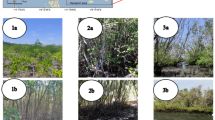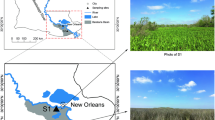Abstract
Tidal freshwater forested wetlands (tidal swamps) are periodically affected by salinity intrusion at seaward transitions with marsh, which, along with altered hydrology, may affect the balance of gaseous carbon (C) and nitrogen (N) losses from soils. We measured greenhouse gas emissions (CO2, CH4, N2O) from healthy, moderately degraded, and degraded tidal swamp soils undergoing sea-level-rise-induced retreat along the lower Savannah River, Georgia, USA. Soil CO2 flux ranged from 90.2 to 179.1 mg CO2 m−2 h−1 among study sites, and was the dominant greenhouse gas emitted. CO2 flux differed among sites in some months, while CH4 and N2O fluxes were 0.18 mg CH4 m−2 h−1 and 1.23 μg N2O m−2 h−1, respectively, with no differences among sites. Hydrology, soil temperature, and air temperature, but not salinity, controlled the annual balance of soil CO2 emissions from tidal swamp soils. No clear drivers were found for CH4 or N2O emissions. On occasion, large ebbing or very low tides were even found to draw CO2 fluxes into the soil (dark CO2 uptake), along with CH4 and N2O. Overall, we hypothesized a much greater role for salinity and site condition in controlling the suite of greenhouse gases emitted from tidal swamps than we discovered, and found that CO2 emissions—not CH4 or N2O–contributed most to the global warming potential from these tidal swamp soils.



Similar content being viewed by others
References
Alford DP, DeLaune RD, Lindau CW (1997) Methane flux from Mississippi River deltaic plain wetlands. Biogeochemistry 37:227–236
Bartlett KB, Bartlett DS, Harriss RC, Sebacher DI (1987) Methane emissions along a salt marsh gradient. Biogeochemistry 4:183–202
Bridgham SD (1991) Mechanisms controlling soil carbon cycling in North Carolina peatlands. Ph.D. dissertation. Duke University, Durham
Chimner RA (2004) Soil respiration rates of tropical peatlands in Micronesia and Hawaii. Wetlands 24:51–56
Clymo RS, Turunen J, Tolonen K (1998) Carbon accumulation in peatlands. Oikos 81:368–388
DeLaune RD, Smith CJ, Patrick WH Jr (1983) Methane release from Gulf coast wetlands. Tellus 35B:8–15
Donato DC, Kauffman JB, Murdiyarso D, Kurnianto S, Stidham M, Kanninen M (2011) Mangroves among the most carbon-rich tropical forests and key in land-use carbon emissions. Nature Geosciences 4:293–297
Ensign SH, Piehler MF, Doyle MW (2008) Riparian zone denitrification affects nitrogen flux through a tidal freshwater river. Biogeochemistry 91:133–150
Faulkner SP, Patrick WH, Gambrell RP (1989) Field techniques for measuring wetland soil parameters. Soil Science Society of America Journal 53:883–890
Forster P, Ramaswamy V, Artaxo P, Berntsen T, Betts R, Fahey DW, Haywood J, Lean J, Lowe DC, Myhre G, Nganga J, Prinn R, Raga G, Schulz M, Van Dorland R (2007) Changes in atmospheric constituents and in radiative forcing. In: Solomon S et al (eds) Climate change 2007: the physical basis. Cambridge University Press, Cambridge, pp 129–234
Freeman C, Lock MA, Hughes S, Reynolds B (1997) Nitrous oxide emissions and the use of wetlands for water quality amelioration. Environmental Science and Technology 31:2438–2440
Garnet KN, Megonigal JP, Litchfield C, Taylor GE Jr (2005) Physiological control of leaf methane emission from wetland plants. Aquatic Botany 81:141–155
Hackney CT, Avery GB, Leonard LA, Posey M, Alphin T (2007) Biological, chemical, and physical characteristics of tidal freshwater swamp forests of the Lower Cape Fear River/Estuary, North Carolina. In: Conner WH, Doyle TW, Krauss KW (eds) Ecology of tidal freshwater forested Wetlands of the Southeastern United States. Springer, New York, pp 183–221
Happell JD, Chanton JP (1993) Carbon remineralization in a north Florida swamp forest: effects of water level on the pathway and rates of soil organic matter decomposition. Global Biogeochemical Cycles 7:475–490
Harriss RC, Sebacher DI (1981) Methane flux in forested freshwater swamps of the southeastern United States. Geophysical Research Letters 8:1002–1004
Harriss RC, Sebacher DI, Day FP (1982) Methane flux in the Great Dismal Swamp. Nature 297:673–674
Harriss RC, Sebacher DI, Bartlett KB, Bartlett DS, Crill PM (1988) Sources of atmospheric methane in the south Florida environment. Global Biogeochemical Cycles 2:231–243
Howard RJ, Mendelssohn IA (2000) Structure and composition of oligohaline marsh plant communities exposed to salinity pulses. Aquatic Botany 68:143–164
Johnson RA, Wichern DW (1988) Applied multivariate statistical analysis, 2nd edn. Prentice Hall, New Jersey
Kelley CA, Martens CS, Ussler WI (1995) Methane dynamics across a tidally flooded riverbank margin. Limnology and Oceanography 40:1112–1129
Krauss KW, Duberstein JA, Doyle TW, Conner WH, Day RH, Inabinette LW, Whitbeck JL (2009) Site condition, structure, and growth of baldcypress along tidal/non-tidal salinity gradients. Wetlands 29:505–519
Lovelock CE (2008) Soil respiration and belowground carbon allocation in mangrove forests. Ecosystems 11:342–354
Megonigal JP, Schlesinger WH (2002) Methane-limited methanotrophy in tidal freshwater swamps. Global Biogeochemical Cycles 16:1088–1098
Miller DN, Ghiorse WC, Yavitt JB (1999) Seasonal patterns and controls on methane and carbon fluxes in forested swamp pools. Geomicrobiology Journal 16:325–331
Montzka SA, Dlugokencky EJ, Butler JH (2011) Non–CO2 greenhouse gases and climate change. Nature 476:43–50
Moore TR, Dalva M (1993) The influence of temperature and water table position on carbon dioxide and methane emissions from laboratory columns of peatland soils. Journal of Soil Science (European) 44:651–664
Moore TR, Knowles R (1989) The influence of water table levels on methane and carbon dioxide emissions from peatland soils. Canadian Journal of Soil Science 69:33–38
Mulholland PJ (1981) Organic carbon flow in a swamp-stream ecosystem. Ecological Monographs 51:307–322
Natural Resources Conservation Service (NRCS) (2011) United States Department of Agriculture, Web Soil Survey, http://websoilsurvey.nrcs.usda.gov/. Accessed 20 September 2011
Neubauer SC, Miller WD, Anderson IC (2000) Carbon cycling in a tidal freshwater marsh ecosystem: a carbon gas flux study. Marine Ecology Progress Series 199:13–30
Noe GB, Hupp CR (2009) Retention of riverine sediment and nutrient loads by coastal plain floodplains. Ecosystems 12:728–746
Pearlstein LG, Kitchens WM, Latham PJ, Bartleson RD (1993) Tide gate influences on a tidal salt marsh. Water Resources Bulletin 29:1009–1019
Pezeshki SR, DeLaune RD, Patrick WH Jr (1987) Response of baldcypress (Taxodium distichum L. var. distichum) to increases in flooding salinity in Louisiana’s Mississippi River Deltaic Plain. Wetlands 7:1–10
Poffenbarger HJ, Needelman BA, Megonigal JP (2011) Salinity influence on methane emissions from tidal marshes. Wetlands 31:831–842
Pulliam WM (1993) Carbon dioxide and methane exports from a southeastern floodplain swamp. Ecological Monographs 63:29–53
Reddy KR, DeLaune RD (2008) Biogeochemistry of wetlands: science and applications. CRC Press, Boca Raton
U.S. Department of Agriculture (USDA) (1974) Soil survey of Bryan and Chatham Counties, Georgia. Soil Conservation Service, Washington
U.S. Department of Agriculture (USDA) (1980) Soil survey of Beaufort and Jasper Counties, South Carolina. Soil Conservation Service, Washington
Weston NB, Dixon RE, Joye SB (2006) Ramifications of increased salinity in tidal freshwater sediments: geochemistry and microbial pathways of organic matter mineralization. Journal of Geophysical Research 111:G0100
Weston NB, Vile MA, Neubauer SC, Velinsky DJ (2011) Accelerated microbial organic matter mineralization following salt-water intrusion into tidal freshwater marsh soils. Biogeochemistry 102:135–151
Wilson JO, Crill PM, Bartlett KB, Sebacher DI, Harriss RC, Sass RL (1989) Seasonal variation of methane emissions from a temperate swamp. Biogeochemistry 8:55–71
Yu KW, Faulkner SP, Patrick WH (2006) Redox potential characterization and soil greenhouse gas concentration across a hydrological gradient in a Gulf Coast forest. Chemosphere 62:905–914
Yu KW, Faulkner SP, Baldwin MJ (2008) Effect of hydrological conditions on nitrous oxide, methane, and carbon dioxide dynamics in a bottomland hardwood forest and its implication for soil carbon sequestration. Global Change Biology 14:1–15
Acknowledgments
This research was funded by the USGS Climate and Land Use Change Research and Development Program. Jamie A. Duberstein, Teresa Fernandez, and James Senter provided field assistance for collection of gas samples, while Scott C. Neubauer, William H. Conner, Christopher B. Craft, and two anonymous referees provided valuable reviews of previous manuscript drafts. We thank Stephen P. Faulkner, Rebecca Moss, and Michael J. Baldwin for analyzing gas samples, Darren Johnson for conducting the statistical analyses, and William Russell Webb, Jane Griess, Robert Rahn, Don Williford, and Chuck Hayes with Savannah NWR for assistance in many aspects of this research from permit writing to providing boats. Any use of trade, product, or firm names is for descriptive purposes only and does not imply endorsement by the United States Government.
Author information
Authors and Affiliations
Corresponding author
Rights and permissions
About this article
Cite this article
Krauss, K.W., Whitbeck, J.L. Soil Greenhouse Gas Fluxes during Wetland Forest Retreat along the Lower Savannah River, Georgia (USA). Wetlands 32, 73–81 (2012). https://doi.org/10.1007/s13157-011-0246-8
Received:
Accepted:
Published:
Issue Date:
DOI: https://doi.org/10.1007/s13157-011-0246-8




